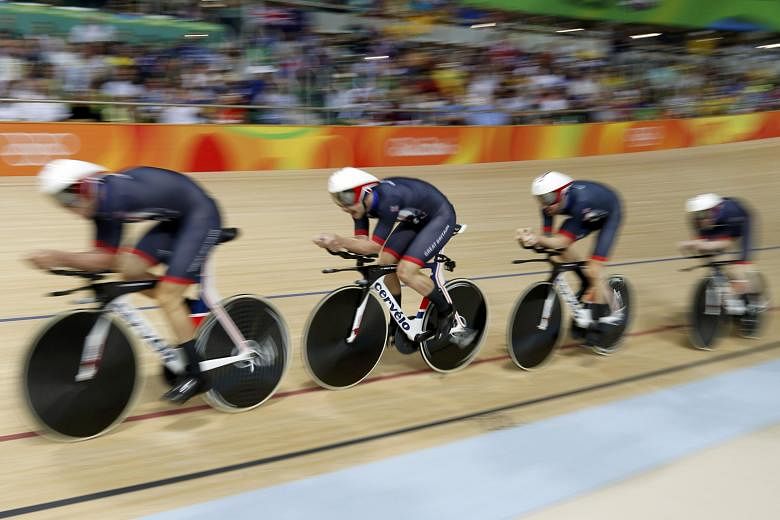When Joseph Schooling won the 100m butterfly at the Rio Olympics, his gold medal for Singapore wasn't the only piece of history made that night.
It was also the first time that three athletes had tied for second place in the Olympics - Michael Phelps of the United States, Chad le Clos of South Africa, and Laszlo Cseh of Hungary, all clocking 51.14 seconds.
You have to take your swimming caps off to the Swiss watch company Omega for recording these times with such precision.
This is such a rare occurrence, its president and chief executive officer, Raynald Aeschlimann, tells me it is one of Omega's defining moments in the Games.
That's quite something to say for a watchmaker that has been official timekeeper since 1932 when it started with just one technician armed with 30 chronographs for the Los Angeles Games.
 Britain's quartet on their way to gold in the team pursuit final against Australia. Cycling requires the most precise timing at the Olympics, taken to a thousandth of a second on the front wheel of the third rider across the line. PHOTO: REUTERS
Britain's quartet on their way to gold in the team pursuit final against Australia. Cycling requires the most precise timing at the Olympics, taken to a thousandth of a second on the front wheel of the third rider across the line. PHOTO: REUTERS Since those tape and measure days, timekeeping has sprinted through the years.
By 1948, photoelectric timing was able to measure to the nearest one-thousandth of a second.
Now, in Rio, Omega brought in 450 tonnes of equipment manned by 480 professionals and 850 trained volunteers.
It's all very high tech; the photo-finish camera, for example, takes 10,000 images per second.
Omega is also the sponsor of my trip here, and I am having the time of my life at the Aquatics Centre watching Schooling beat the greatest Olympian swimmer of all time, Phelps.
I have to thank my lucky stars for being here on the night Singapore's golden hope was in action during my three-day visit.
It is my very last day and this is the final event in the programme Omega had arranged for us, and it had to be the 100m butterfly final.
After watching canoe slalom, rugby, basketball and cycling earlier - none of which involved Singapore athletes - this was what I had travelled 16,000km and 24 hours to watch.
Schooling's performance and the way Singaporeans celebrated were so memorable, they overshadowed everything else I experienced in the South American city.
But there is something about being in an Olympic city, with 10,600 athletes from 207 teams competing in 28 sports in 34 venues.
You need a marathoner's stamina to take in everything - if you can get through Rio's traffic.
Travelling with Omega though, we glide along the city's highways in our coaches on lanes reserved for Olympic vehicles, while other traffic crawled slower than a butterfly swimmer.
If you're on your own and want to watch more than one sport a day, best to park yourself at the Barra Olympic Park, home to nine venues including swimming, cycling, tennis, basketball and gymnastics.
It's a very different experience being here compared to watching the Games on television.
In front of the goggle box, you see the action up close, every movement captured, and in slow motion and glorious colours.
You can also watch many more sports, switching between channels (alas, if you're in Singapore, you can do this only through Toggle TV).
But there are some things the camera won't catch.
At the men's rugby sevens final between Fiji and Britain, you wouldn't have known how partisan the crowd was for the Pacific nation. I doubt if many Fijians made the journey to Rio, but you would think they all did going by the noise the spectators made every time the Fijian team were on the move.
Which was plenty because they trounced Britain 43-7.
In the Olympics, you get to see the underdogs getting the loudest cheers a lot.
It was also my first time at a cycling event in a velodrome and you have to be there to see precision in motion during the team races.
There are four cyclists in each team and they pedal like the wind at more than 70kmh in single file - the speed limit on many Singapore roads - but they are centimetres apart from each other.
It makes F1 racing look like a lazy Sunday drive.
One lasting impression in Rio which had nothing to do with sports and everything with the troubled times we live in: The sight of security forces everywhere.
There were armed soldiers with assault rifles, on horseback, and in armoured vehicles.
The Olympics are probably the safest time to visit Rio, and I didn't feel unsafe at any time.
What about the other terror that had frightened the world's top golfers, including Jason Day and Rory McIlroy, into not competing?
Zika?
I saw a grand total of one mosquito.
Too quickly, my three days flew by .
Omega timed that precisely as well.
•The writer's trip to the Rio Olympics was sponsored by Omega

